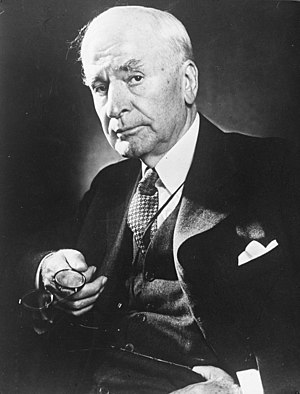Cordell Hull: Difference between revisions
Pat Palmer (talk | contribs) (adding an image) |
mNo edit summary |
||
| (4 intermediate revisions by one other user not shown) | |||
| Line 1: | Line 1: | ||
{{subpages}} | {{subpages}} | ||
{{Image|Portret Cordell Hull, Bestanddeelnr 901-9328.jpg|right| | {{Image|Portret Cordell Hull, Bestanddeelnr 901-9328.jpg|right|300px|Cordell Hull in 1946.}} | ||
'''Cordell Hull''' | '''Cordell Hull''' (1871-1955) was the longest-serving [[U.S. Secretary of State]] (1933-1944) and winner of a [[Nobel Peace Prize]] for contributions to international organizations and negotiations to avert [[World War Two in the Pacific]]. He was also an attorney and political leader. | ||
==Early career== | ==Early career== | ||
==Pre-WWII== | ==Pre-WWII== | ||
| Line 24: | Line 25: | ||
{{reflist}} | {{reflist}} | ||
[[Category:Reviewed Passed if Improved]] | [[Category:Reviewed Passed if Improved]][[Category:Suggestion Bot Tag]] | ||
Latest revision as of 06:00, 2 August 2024
Cordell Hull (1871-1955) was the longest-serving U.S. Secretary of State (1933-1944) and winner of a Nobel Peace Prize for contributions to international organizations and negotiations to avert World War Two in the Pacific. He was also an attorney and political leader.
Early career
Pre-WWII
He engaged in extensive negotiations, in 1941, with Japanese Ambassador Kichisaburo Nomura and other officials trying to find a formula to avert the war. American intelligence officers thought he was the best Japan could send, but the situation was beyond correction. Pacific Fleet intelligence officer Edwin Layton wrote "Nomura was one of the few senior Japanese officials I knew who had real affinity for and understanding of the United States. His appointment at this critical time was a signal of Tokyo's intent to calm American concern. If anyone could have done it, Nomura was the man." [1] Layton, however, considered Nomura naive in proposing ideas that his government, which would have been unacceptable to the Japanese military leadership. Nomura reported that there was special American sensitivity over French Indochina.
26 November meeting
Cordell Hull negotiated extensively with Nomura, trying to avoid war. A memorandum from Hull to the Japanese,[2] became one of the key factors in the Japanese decision for war in 1941. Privy Council President Yoshimichi Hara, who referred to the memorandum reporting the 26 November meeting with Hull and the Japanese ambassadors, quoting it (emphasis added) as "the United States has demanded we withdraw troops from all of China." The actual English text read only "China". Hara asked for clarification, and Foreign Minister Togo said it was unclear if Manchuria had been separated. Throughout the Nomura-Hull talks, China and Manchuria had always been separated,a confusing explanation from Togo, no one at the conference assumed so. Hara concluded that war was preferable to accepting the American proposal because
If we were to give in [to the United States, then we would not only give up the fruits of the Sino-Japanese War, and the Russo-Japanese War, but also abandon the results of the Manchurian Incident. There is no way we could endure this....It is clear that the existence of our empire is threatened, that the great achievements of the Emperor Meiji would all come to naught, and that there is nothing else we can do.[3]
References
- ↑ Edwin T. Layton, Roger Pineau and John Costello (1985), "And I was There": Pearl Harbor and Midway: Breaking the Secrets, William Morrow & Company, ISBN 0688948838, p. 81
- ↑ Document Handed by the Secretary of State (Hull) to the Japanese Ambassador (Nomura) (26 November 1941), Outline of Proposed Basis for Agreement between the United States and Japan
- ↑ Herbert P. Bix (2001), Hirohito and the making of modern Japan, Harper Perennial, ISBN 978-0060931308, pp. 431-422
- Pages using ISBN magic links
- CZ Live
- History Workgroup
- Politics Workgroup
- Military Workgroup
- International relations Subgroup
- Pacific War Subgroup
- World War II Subgroup
- Articles written in American English
- All Content
- History Content
- Politics Content
- Military Content
- History tag
- Military tag
- International relations tag
- Pacific War tag
- World War II tag
- Reviewed Passed if Improved
